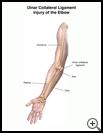
Ulnar Collateral Ligament Injury of the Elbow
________________________________________________________________________
KEY POINTS
- A ulnar collateral ligament injury is stretching or tearing of the strong band of tissue that connects the bone of your upper arm to the bone on the little finger side of your lower arm.
- Change or stop doing the activities that cause pain until the injury heals.
- A wrist sprain can be treated with splints or slings, ice, and sometimes with medicine or surgery.
________________________________________________________________________
What is an ulnar collateral ligament injury of the elbow?
An ulnar collateral ligament injury is an injury to a ligament in your elbow. Ligaments are strong bands of tissue that connect one bone to another to form the joints. The ulnar collateral ligament attaches the bone in the upper arm to the lower arm bone (ulna) that forms the bony point of the elbow. The lower end of the ulna connects to the wrist on the pinky finger side of the hand.
When a ligament is injured, it can be stretched, partially torn, or completely torn. A ligament injury is also called a sprain.
What is the cause?
Ulnar collateral ligament injuries can be caused by:
- Overuse of the ligament from a sport or work activity that puts stress on your inner elbow, such as repeated throwing in baseball or football. The stress on the elbow can cause very tiny tears that get worse over time.
- A sudden activity that twists or tears a ligament, such as a fall onto your elbow or onto an outstretched hand. The ligament can also be injured if another person lands on your elbow.
What are the symptoms?
Symptoms may include:
- Pain on the inner side of your elbow
- Numbness in your pinky finger
- Swelling and weakness
- Loss of power with throwing
How is it diagnosed?
Your healthcare provider will ask about your symptoms, activities, and medical history and examine you. You may have X-rays or other scans, such as:
- An ultrasound, which uses sound waves to show pictures of your elbow joint
- An MRI, which uses a strong magnetic field and radio waves to show detailed pictures of your elbow joint
- An arthrogram, which is an X-ray or MRI taken after a dye is injected into your joint to outline its shape
How is it treated?
You will need to change or stop doing the activities that cause pain until the ligament has healed. For example, if you have an overuse injury from playing baseball or football, it is very important to rest from throwing. If the problem is diagnosed early and you have a partial tear, rest for 3 to 6 weeks may be enough. Sometimes the rest period needs to be longer. After that rest period a gradual return to throwing may need to be supervised by your healthcare provider, physical therapist or athletic trainer.
Your healthcare provider may recommend stretching and strengthening exercises to help you heal.
You may need a splint or a sling for several weeks to keep your elbow from moving while it heals.
If the ligament is completely torn, you may need surgery to repair it. You may also need surgery if you have a partial tear that does not get better with rest and exercises.
The pain often gets better within a few weeks with self-care, but some injuries may take several months or longer to heal. It’s important to follow all of your healthcare provider’s instructions.
How can I take care of myself?
To keep swelling down and help relieve pain for the first few days after the injury:
- Put an ice pack, gel pack, or package of frozen vegetables wrapped in a cloth on the injured area every 3 to 4 hours for up to 20 minutes at a time.
- Keep your arm up on pillows so that it is above the level of your heart when you sit or lie down.
- Take nonprescription pain medicine, such as acetaminophen, ibuprofen, or naproxen. Read the label and take as directed. Unless recommended by your healthcare provider, you should not take these medicines for more than 10 days.
- Nonsteroidal anti-inflammatory medicines (NSAIDs), such as ibuprofen, naproxen, and aspirin, may cause stomach bleeding and other problems. These risks increase with age.
- Acetaminophen may cause liver damage or other problems. Unless recommended by your provider, don't take more than 3000 milligrams (mg) in 24 hours. To make sure you don’t take too much, check other medicines you take to see if they also contain acetaminophen. Ask your provider if you need to avoid drinking alcohol while taking this medicine.
Follow your healthcare provider's instructions, including any exercises recommended by your provider. Ask your provider:
- How and when you will get your test results
- How long it will take to recover
- If there are activities you should avoid and when you can return to your normal activities
- How to take care of yourself at home
- What symptoms or problems you should watch for and what to do if you have them
Make sure you know when you should come back for a checkup. Keep all appointments for provider visits or tests.
How can I help prevent an ulnar collateral ligament injury of the elbow?
Warm-up exercises and stretching before activities can help prevent injuries. If your arm hurts after exercise, putting ice on it may help keep it from getting injured.
Follow safety rules and use any protective equipment recommended for your work or sport.
Avoid activities that cause pain. For example, don't throw too much and stop your activity if your elbow hurts.

